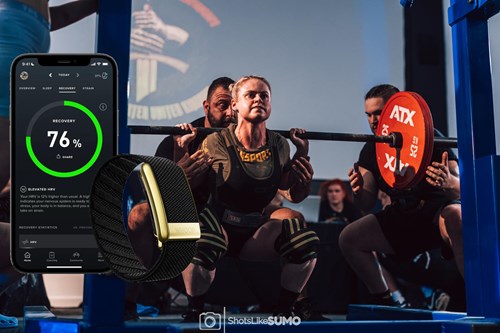
Introduction
Enhanced athletes. Those individuals who optimise their training, nutrition, and recovery with the supplementation of performance enhancing drugs. Just like all good things, there is a cost to doing business, and pushing their bodies past the natural limits comes with a price tag: risks to their health. Most people get caught in the trap of only seeing as far as their next 12 week cycle for their next competition, or planning their next off-season PED protocol, but rarely think about where their health is going to be in 10, 15, 20 years’ time for both males and females.
Despite the article title being aimed at enhanced athletes, natural athletes can take note of these too.
Daily Tracking
Resting Heart Rate, Average Heart Rate, Cardio Heart Rate, Heart Rate Variability
Whoop, Fitbit, Apple watch are all great tools to measure cardio health with RHR and tracking cardio heart rate and how fast a raised heart rate can come back down.
RHR and HRV are great metrics at looking at overall recovery capabilities and cardio effort. Trained athletes should be looking for at least <60bpm RHR, and the higher the HRV the better. The HRV is an overall look at the general CNS tone of being sympathetic or parasympathetic (1). Our recovery is best when we’re in a parasympathetic state, and low HRV could indicate being stuck in too much of a sympathetic state which not only affects recovery, but also athletic performance in general.
PED usage can affect all these areas – increasing RHR, eliciting a CNS response to a more sympathetic state (2), so reducing the overall HRV, so it’s basically a window into what your overall state of your cardio and CNS is.
Not used a Whoop and want your first month free, with no upfront cost? Click here and start tracking your metrics!

Blood Glucose
The frequency of checking blood glucose levels depends on the athlete's individual needs and is not necessarily a daily routine unless it's deemed necessary. Athletes, particularly those who are lightweight Strongman/Strongwoman competitors or Powerlifters with a relatively lean physique who closely manage their diet, may not find it essential to monitor their blood glucose on a daily basis. Instead, they might opt for weekly checks or occasional monitoring, such as after meals, based on their specific requirements during different training phases.
For heavier weight athletes, who have increased food intake and exposing themselves to PEDs and growth hormones, whilst having higher body fat and visceral fat can lead to inflammation, oxidation, insulin resistance (3) and poor fuel partitioning. Health outcomes may suffer with this, and blood glucose levels can provide early insights into these.
Monitoring can occur daily (fasted upon waking), or a few times a week to keep tabs on levels. After meals, or just once a week too depending on the athlete’s specific needs. If issues arise, then strategies should be implemented to mitigate health risks.
For natural athletes, and lightweight athletes, who are relatively lean, daily monitoring might not be necessary. Instead, periodic HbA1c tests every three months can suffice unless there are diabetes risk factors to consider such as a history of diabetes in the family.
Blood glucose monitors are readily available through Amazon.
Menstrual Cycle and Basal Body Temperature (for Females)
Females should track their menstrual cycle and potentially basal body temperature if they are capable of menstruating. The menstrual cycle is a vital indicator of female health, offering insights into stress levels and metabolic function. Changes in the menstrual cycle, such as missed cycles or irregularities, may signal issues like PCOS or thyroid dysfunction, affecting physical outcomes. Secondary amenorrhea (the absence of three or more periods in a row) can be induced through stressors related to training and nutrition (4), so keeping tabs on a healthy, regular period is one method of gauging how healthy an individual female athlete is.
Basal body temperature rises after ovulation due to increased progesterone levels. Tracking this can help pinpoint optimal times for peak strength performance, muscle gain and fat loss. Various apps and devices, such as menstrual cycle trackers and thermometers, can aid in monitoring these metrics.
For enhanced female athletes, or females on TRT, tracking the menstrual cycle can also keep track if androgenic compounds are affecting the regular cycles. Androgenic compound use can suppress the menstrual cycle, and our goal should be to try and preserve this as much as possible, or if it is suppressed due to an athlete’s needs, then recovering this should be a priority when the athlete is in a phase of training/nutrition that supports it.
Weekly Tracking
Blood Pressure
Blood pressure is a silent health risk that affects both PED-using and natural clients. Monitoring blood pressure is essential as high blood pressure can strain the heart, leading to cardiomegaly and left ventricular hypertrophy (LVH) and further diseases such as Hypertrophic cardiomyopathy (HCM) (5). It's especially prevalent in PED users.
Also not to mention blood pressure doesn’t only affect the heart, but it can affect kidney function as well. Due to the excessive pressure on veins and arteries, organs like the kidneys can be damaged (6) and also affect cerebral blood flow (7).
Weekly blood pressure checks can help detect and manage hypertension early and other cardiovascular disease (CVD) risks.
Monthly Tracking
Blood Tests
Every 12 weeks, serum blood work and Urinalysis should be taken. A natural athlete wouldn’t need to get these that often, but possibly a bi-annual or annual blood panel could be done.
Every 12 weeks for enhanced athletes though, as we commonly work in 12 week phases with periodisation and PED periodisation too, where PED usage increases and decreases, so we should be monitoring the response to those cycles regularly.
Urinalysis is a good way to check for protein in the urine, which it should not be, and is more of an indicator for kidney issues that can be coupled with the kidney functionality blood work.
The blood panels are an overall health and performance evaluation, and of course looking at hormone panels too to make sure we’re optimised in that area too as performance athletes.
Female Blood Tests
We’ve already touched on monitoring the menstrual cycle for females, but we can also time blood panels around the menstrual cycle too. Depending which phase a female is in during her menstrual cycle (follicular phase or luteal phase) governs which is the dominant hormone at the time. Follicular phase will see a spike in estrogen levels and luteinizing hormone (LH) as the follicles mature before ovulation, and then during ovulation at around day 14, we’ll see a spike in testosterone. Through the luteal phase progesterone rises until the next menstruation where there’s a low period of hormones.
So, blood panels can be timed around those phases to check estrogen/progesterone levels, and of course testosterone, for how healthy the menstrual cycle is.
Voice Pitch Analyser
Androgenic PED exposure to females can change and thicken the vocal cords, causing a deeper voice (8). The Voice Pitch Analyzer app is a great way to measure pitch, by making you record you reading out a short story and categorises your voice into a feminine voice or a masculine voice, and so you can then track any changes overtime.
Straw phonation work is a good way to try and prevent voice changes as a vocal exercise.
Annual Tracking
Echocardiogram
An echocardiogram, often referred to as an "echo”, uses ultrasound to create a real time image of the heart to measure heart functionality, blood flow and structure/thickness of the arterial walls.
They’re able to detect cardiac abnormalities, and as we already mentioned, PED use can lead to LVH, MCH and other cardiovascular diseases (9).
LVH can occur in natural athletes as an adaptive response to training (10) and can range between different populations (11-14):
Gen Pop Male: 5-9mm
Natural Trained Male Athlete: 9-11mm
Enhanced Male Athlete: 10-15mm
Gen Pop Female: 4-8mm
Natural Trained Female Athlete: 8-10mm
Normal Enhanced Female Athlete: 9-14mm
This is why an annual echocardiogram should be a non-negotiable to differentiate acceptable LVH and pathological LVH. The main cause of death in PED users is heart disease, so despite being expensive, annual echocardiograms are useful to get ahead and have a way to track trends with heart function.
Gynaecologist Exam
Another one for the females, an annual gynaecologist exam.
Cervical screenings, checking for proper reproductive health function. This is something quite a few females skip out on, but just like hormone blood tests, we want to make sure reproductive health is also as good as it can be.
It’s easy to get caught up in what’s happening in the next 12 weeks, 6 months, 1-2 years in terms of training and PED usage, so while right now having children might not be your highest priority, what about in the next 10, 15, 20 years’ time?
We should be looking at longevity and trying to preserve a healthy reproductive system for not only now, but the future.
Final Thoughts
There’s no free meal ticket with the usage of PEDs and whilst natural athletes should also be thinking about their overall health, it becomes a necessity with androgenic compound usage.
Cardiovascular diseases are known as the silent killers. Regular blood tests only paint a part of the overall picture when we can keep track of overall cardio health with fitness trackers and annual echocardiograms, and regular blood pressure monitoring.
This also goes for female athletes, keeping tabs on their menstrual cycle (if they are capable of menstruating), and monitoring their overall reproductive health.
For both males and females, it’s easy to get caught up in the now, and we set goals for the current mesocycle, the next 6 months, the next 1-2 years, but rarely thing about our health in the next 10, 15, 20 years.
Whilst some of these come with the extra cost of running a cycle, you can't put a price on your health and if you are cycling PEDs then you should be spending the time and money looking after your health too.
Disclaimer: Harrison Fleetwood is not a doctor or registered medical practitioner. The contents of this article should not be taken as medical advice and is not intended to replace the advice of a doctor or qualified health professional on issues regarding your health.
References
1. Heart Rate Variability and Cardiac Vagal Tone in Psychophysiological Research – Recommendations for Experiment Planning, Data Analysis, and Data Reporting https://www.ncbi.nlm.nih.gov/pmc/articles/PMC5316555/
2. Long-term anabolic steroids in male bodybuilders induce cardiovascular structural and autonomic abnormalities https://pubmed.ncbi.nlm.nih.gov/29019018/
3. Obesity, Insulin Resistance, and Type 2 Diabetes: Associations and Therapeutic Implications https://www.ncbi.nlm.nih.gov/pmc/articles/PMC7553667/
4. Hypothalamic Amenorrhea and the Long-Term Health Consequences https://www.ncbi.nlm.nih.gov/pmc/articles/PMC6374026/
5. Anabolic Androgenic Steroids Induce Reversible Left Ventricular Hypertrophy and Cardiac Dysfunction. Echocardiography Results of the HAARLEM Study https://www.ncbi.nlm.nih.gov/pmc/articles/PMC9580689/
6. Association between blood pressure and the risk of chronic kidney disease in treatment-naïve hypertensive patients https://www.ncbi.nlm.nih.gov/pmc/articles/PMC8816410/
7. The Cerebral Circulation https://www.ncbi.nlm.nih.gov/books/NBK53082/
8. Functional Voice Testing Detects Early Changes in Vocal Pitch in Women During Testosterone Administration https://www.ncbi.nlm.nih.gov/pmc/articles/PMC4454796
9. Cardiac effects of anabolic steroid use amongst recreational body builders - a CMR study https://jcmr-online.biomedcentral.com/articles/10.1186/1532-429X-14-S1-P186
10. StatPearls - Left Ventricular Hypertrophy https://www.ncbi.nlm.nih.gov/books/NBK557534/
11. Distinguishing hypertrophic cardiomyopathy from athlete’s heart: a clinical problem of increasing magnitude and significance https://www.ncbi.nlm.nih.gov/pmc/articles/PMC1769182/
12. Left ventricular hypertrophy in athletes and hypertensive patients https://www.ncbi.nlm.nih.gov/pmc/articles/PMC8031199/
13. Left ventricular hypertrophy in athletes https://academic.oup.com/ehjcimaging/article/10/3/350/2396955
14. Left-Ventricular Hypertrophy in a Rugby Player on Anabolic Steroids: A Case Study https://journals.humankinetics.com/view/journals/ijatt/10/6/article-p25.xml



